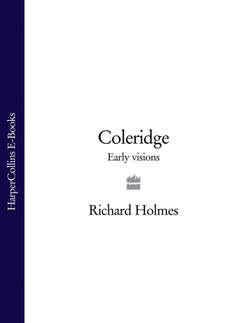Читать книгу Coleridge: Early Visions - Richard Holmes - Страница 22
6
ОглавлениеThe year 1789 was a turning point for Coleridge’s whole generation. With the fall of the Bastille in July, the first tide of revolutionary excitement flooded through Europe, reaching even into the remote cloisters of Christ’s Hospital. The sixteen-and-a-half-year-old Coleridge now wrote his first substantial and original poem, “The Fall of the Bastille”. In it he records the “universal cry” of liberty from “Gallia’s shore”, and imagines the spirit of freedom reaching down even to the humble field-labourer:
…mark yon peasant’s raptur’d eyes;
Secure he views his harvests rise;
No fetter vile the mind shall know,
And Eloquence shall fearless glow…27
The excitement was indeed universal, and a hundred such Odes filled the newspapers and magazines: “bliss was it in that dawn to be alive”. Wordsworth, already at Cambridge, felt the same sudden intensification of life among the undergraduates, and planned a walking tour in France for the following summer. But perhaps Coleridge alone characteristically pointed out that language itself – “Eloquence” – had been freed.
Feeling his wings and independence for the first time, he visited Ottery during the summer, where he went through the solemn rite of recarving his initials in the Pixies’ Parlour, alongside those of his distant brothers. He learned too that his beloved sister Nancy was gravely ill, and this appears in one of his earliest sonnets, “Life”, dated September 1789, “musing in torpid woe a Sister’s pain”.28 Another sonnet, “To the Autumnal Moon”, also belongs to this period.
This quickening of the poetic impulse – he produced two more translations for Bowyer’s “Album” – reflects another outside influence. Thomas Middleton, now at Pembroke College, Cambridge, sent him a copy of the second edition of William Bowles’ Sonnets. This was one of those books, now largely forgotten, which magically captured the spirit of the times; Coleridge was so excited by it that he wrote out by hand no less than forty copies to give to friends during his last eighteen months at school.29
The collection, a slim octavo volume in fine bold print, consisted of twenty-one sonnets, “Written chiefly on Picturesque Spots, During a Tour”, which Bowles had made through Wales, Scotland, France and Germany in the previous year, while recovering from an unhappy love-affair. It concentrates notably on the evocative, melancholy feelings of seashores and river banks – the shores of Tynemouth, Dover, Ostend; the rivers Tweed, Wenbeck, Itchin, and the Rhine. Bowles, born in the West Country and a graduate of Trinity College, Oxford, exactly ten years older than Coleridge, brilliantly captured a new Romantic sense of spiritual isolation and nostalgia for childhood, projecting into natural surroundings the image of a rootless, wandering poet at the mercy of his dreams and memories.
Coleridge could instantly recognise this aspect of himself in many of the gentle, highly musical, and nakedly emotional sonnets, with their familiar imagery, such as “The Bells, Ostend”:
…And hark! with lessening cadence now they fall!
And now, along the white and level tide,
They fling their melancholy music wide;
Bidding me many a tender thought recall
Of summer-days, and those delightful years
When from an ancient tower, in life’s fair prime,
The mournful magic of their mingling chime
First waked my wondering childhood into tears!
In discovering Bowles, Coleridge found that for the first time in his life he was reading “a contemporary”; unlike the remote classics, these poems possessed an immediate reality of circumstances for him, so as to “inspire an actual friendship as of a man for a man”. They assumed “the properties of flesh and blood”.30 For the next five years, until he became aware of Wordsworth (who had also been greatly struck by Bowles, stopping to read through the entire volume while crossing London Bridge), they were the dominant influence on his own poetry, though he could only match the “austere” style – “so tender and yet so manly, so natural and real” – intermittently.
In fact throughout this period of apprenticeship there was a long struggle between the “florid diction” and epigrammatic polish and personifications of many of his longer and more formal Odes, Effusions and Monodies; and the Bowles-like plain style, expressing emotion in run-on lines, musical alliteration, and bold monosyllabic statements of personal feeling. This second style – a profound attack on eighteenth-century conventions – became particularly evident in his own shorter pieces and sonnets composed between 1789 and 1794. These included many sonnets about his own experience of change and loss, and family griefs: “To the Autumnal Moon”; “Pain”; “On Quitting School for College”; “On Receiving an Account that his only Sister’s Death was Inevitable”; and his masterpiece in the Bowles’ style (but wonderfully transforming it) “To the River Otter”.
In the Biographia he well described what he was groping after, as a poetry “of the lines running into each other, instead of closing at each couplet, and of natural language, neither bookish, nor vulgar, neither redolent of the lamp, nor of the kennel [the gutter], such as ‘I will remember thee’; instead of the same thought tricked up in the rag-fair finery of – ‘Thy image on her wing/Before my Fancy’s eye shall Memory bring.’”31 He counted Bowles’ poetry, along with the friendship of Tom Evans’ family, as the two humanising forces in his academic life as a Grecian. Between them, they drew him out of the bookish maze of metaphysics and classical philosophy, into the living world.32
